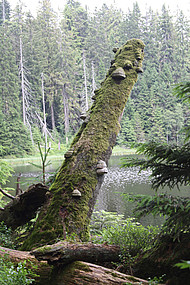Mycological investigations in the former protected forest Wilder See (Northern Black Forest)
From 2013 to 2019, the fungal diversity was recorded in the almost in the Wilder See area, an area covering almost 150 h in new Black Forest National Park. The project is a citizen science project led by the Karlsruhe Natural History Museum (Markus Scholler) and the Black Forest National Park (Flavius Popa) with 30 mostly volonteer collaborators. The project was financed by the Black Forest National Park, the Regional Council of Karlsruhe, the Natural History Museum in Karlsruhe and the LBBW. The area is still a very young primeval forest area with a few stands of old-growth forest, in which the forestry influence with the dominance of the red spruce (Picea abies) is still recognizable and the original red beech-silver fir forest is only preserved in a few small areas. Including 125 historical specimens (collected by Hermann Neubert from 1969 to 2002), 723 species and almost 2400 specimens could be identified, including less well-studied groups such as aquatic fungi, mycophilic fungi and plant-parasitic microfungi. All specimens were deposited in the fungus herbarium of the Natural History Museum. The potential number of species was calculated at around 1.261. In addition to traditional light microscopic methods, molecular biological methods (rDNA barcodes) were used to determine and clarify the life cycles of host-altrnating rust fungi. The results were published in 2021 in the first issue of the scientific journal "Forschung im Nationalpark Schwarzwald". Each species is discussed and many of the species were illustrated. The results are also discussed taking into account anthropogenic influences (granite gravel roads, climate shift, forest history) and the importance of silver fir for mycodiversity. The mycological studies in the Wilder See area will be continued under the direction of the Black Forest National Park.
Selected Publications
- Scholler M., Popa F. (Hrsg.) (2021):
- Die Pilze des ehemaligen Bannwalds Wilder See im Nationalpark Schwarzwald unter besonderer Berücksichtigung der mit Abies alba (Weiß-Tanne) vergesellschafteten Arten. Forschung im Nationalpark Schwarzwald 1: 1-480; https://cloud.landbw.de/index.php/s/27rC3qcQd2LRMHP






